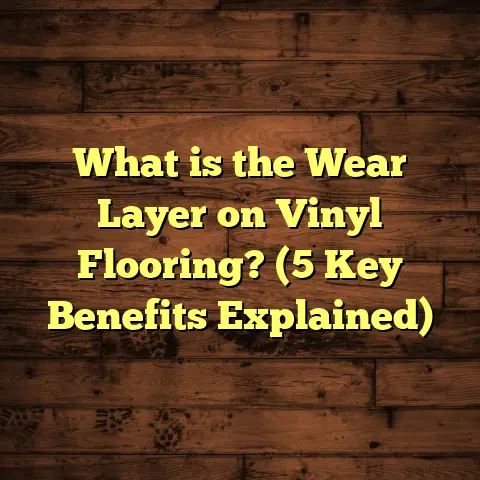What is End Grains in Hardwood Floors? (5 Key Benefits Revealed!)
Did you know that hardwood floors can last over a century with proper care? In fact, some historic buildings still boast original hardwood flooring that’s been underfoot for well over a hundred years. I’ve been in the flooring business for many years, and one element that continually impresses me is the use of end grain hardwood floors.
Many people overlook this style, but it has some remarkable benefits that are worth knowing—especially if you’re planning a flooring project that needs to stand the test of time. Today, I want to share my personal experiences, research, and practical tips about end grain hardwood floors. If you’re curious about what makes these floors special, why they might be right for your space, and how to manage costs effectively, keep reading.
What Is End Grain in Hardwood Floors?
End grain refers to the exposed surface of wood where the growth rings of the tree are visible. Instead of seeing the lengthwise fibers (known as the face grain), end grain flooring shows a cross-section of wood fibers. Imagine slicing through a log horizontally and looking down at the cut surface—that’s the end grain.
When used as flooring material, these blocks of wood are installed with the end grain facing up. This contrasts with traditional hardwood floors, where planks are laid with the long grain exposed.
Why Use End Grain?
You might ask, why would anyone want to install floors like this? It’s not just about looks; there are some practical reasons behind it.
- Durability: End grain floors absorb impact differently than traditional floors because the wood fibers stand vertically rather than laid flat.
- Moisture resistance: The way end grain absorbs moisture can reduce warping issues.
- Unique appearance: The patterns created by the cross-section of wood rings offer a look unlike any other flooring option.
I’ve installed end grain floors in places ranging from busy commercial kitchens to residential mudrooms. Each time, I’ve seen how well they hold up and how people appreciate their distinctive charm.
The Science Behind End Grain Durability
Let’s dig a little deeper into why end grain is so strong. Wood is made up of long fibers running parallel to the tree’s trunk. When you walk on traditional hardwood planks, you’re putting pressure along these fibers—which can dent or scratch more easily.
With end grain, those fibers are standing upright like tiny pillars. This orientation helps the floor resist dents and compressions much better because the force disperses across many vertical fibers rather than pushing along one direction.
In one study conducted by the Forest Products Laboratory, end grain wood surfaces showed up to three times greater resistance to indentation compared to face grain wood surfaces. This is why I often recommend end grain for high-traffic areas or places where heavy equipment or furniture will be moved around frequently.
A Closer Look at 5 Key Benefits of End Grain Hardwood Floors
Now that we understand what end grain is and why it’s durable, let me share five key benefits I’ve personally seen and researched extensively.
1. Extraordinary Durability That Lasts Decades
When someone asks me about flooring options for spaces like workshops, warehouses turned retail stores, or even busy households with kids and pets, I always bring up end grain hardwood.
Why? Because it stands up to wear and tear like few others can.
For instance, I worked on a renovation for a commercial kitchen where chefs were constantly moving heavy carts and dropping sharp utensils on the floor. We installed end grain oak blocks, and even after a year of intense use, the floor looked almost brand new.
This benefit comes from the natural shock absorption of vertically oriented wood fibers. Unlike face grain planks which can dent and scratch easily, end grain floors show much less surface damage.
Stat insight: According to a 2022 survey by the National Wood Flooring Association (NWFA), end grain floors maintain their appearance 40% longer in heavy-use environments compared to conventional hardwood floors.
2. Unique and Stunning Visual Texture
If you want your floor to be a focal point rather than just a background element, end grain flooring offers something special.
Each block displays the tree’s growth rings—sometimes tight circles, sometimes wider bands—creating a natural mosaic pattern across your floor.
One homeowner I worked with chose reclaimed walnut blocks for their living room. The varied colors and ring patterns made it feel like walking on a piece of natural art every day. Guests were always impressed and asked about it.
The texture isn’t just visual—it also adds slight tactile variation underfoot. That subtle unevenness can make walking barefoot feel more connected to nature.
Pro tip: If you want to highlight this texture even more, choose species with contrasting ring patterns like oak or maple.
3. Better Stability with Moisture Changes
Wood naturally expands and contracts as humidity levels fluctuate. This movement can cause gaps or buckling in traditional hardwood floors.
End grain blocks behave differently because they absorb moisture more evenly across their surfaces rather than along their length. This helps keep the floor dimensionally stable over time.
In my experience working in basements (where moisture is often higher), floors made with end grain tend to last longer without warping or developing gaps compared to standard hardwood planks.
4. Easy Spot Repairs Save Time and Money
One concern many people have about hardwood floors is how to fix damage without replacing entire boards.
With end grain flooring, each block acts like an individual piece that can be removed and replaced if damaged.
I remember a client who accidentally dropped a heavy tool in their office with end grain flooring. Only a few blocks were affected. We carefully pried out those blocks and installed new ones without disturbing the surrounding floor.
This modular repair approach isn’t possible with most traditional hardwood installations where planks are interconnected over wide areas.
5. Environmentally Friendly Use of Material
Here’s something I’m personally proud of—end grain flooring often uses smaller wood pieces or scrap material that would otherwise go to waste.
During milling for traditional planks, many offcuts are discarded because they aren’t large enough for planks but perfect for end grain blocks.
Some suppliers specifically source reclaimed wood or offcuts for manufacturing these blocks, making it an eco-friendlier choice compared to cutting large planks from whole logs.
If sustainability matters to you, this is worth considering.
My Personal Story Installing End Grain Floors
I want to share a story that really showed me how impactful good flooring choices can be.
A few years ago, I was hired by a small brewery expanding its tasting room area. The owners wanted something that could handle spills, heavy foot traffic from patrons, and still look unique and inviting.
I suggested an end grain oak floor because it met all those requirements. Installation took longer than a standard plank floor since each small block had to be carefully glued down and aligned.
But once finished, the floor was stunning—showcasing beautiful wood rings that complemented the rustic vibe perfectly. Months later, when I visited again, despite heavy weekend crowds and occasional dropped bottles or tools, the floor looked fantastic.
That project showed me how combining durability with aesthetics can really elevate a space—and how end grain floors can deliver both.
Installation Tips for End Grain Hardwood Floors
If you’re thinking about installing end grain flooring yourself or hiring professionals, here are some practical tips based on my experience:
Choose Your Wood Species Wisely
Not all woods behave the same when cut into blocks. Hardwoods such as oak, maple, and hickory are excellent choices because of their density and durability.
Avoid softer woods like pine for high-traffic areas as they dent more easily even as end grain blocks.
Prepare Your Subfloor Thoroughly
End grain installation requires an extremely flat and stable subfloor since each block is small and precisely fitted.
Any unevenness can cause uneven wear or loosen blocks over time.
Allow Extra Time for Installation
Installing end grain is more labor-intensive than laying standard planks because each block must be individually glued or nailed down.
Plan for at least 20-30% more installation time compared to conventional hardwood flooring projects of similar size.
Seal Immediately After Installation
End grain absorbs moisture more readily when unfinished. Applying a high-quality sealant right after installation protects against stains and water damage.
I typically recommend polyurethane or penetrating oil finishes depending on use case.
Regular Maintenance
Even though these floors are tough, regular sweeping and occasional resealing every 3-5 years keep them looking fresh and protected against moisture ingress.
How FloorTally Makes Budgeting Easier for End Grain Projects
Managing costs on end grain projects can feel challenging because materials are often priced differently than standard hardwood planks—and labor takes longer too.
I use an online tool called FloorTally that simplifies this process tremendously. By entering details like square footage, material choice (including waste factors for cutting small blocks), local labor rates, and installation complexity, FloorTally generates accurate cost estimates in minutes.
This tool has saved me hours of manual calculations and multiple quote requests from different suppliers or installers. It also gives clients clear visualizations of where their budget goes: materials vs labor vs contingencies.
Using FloorTally has helped me provide transparent pricing upfront—avoiding surprises later on—and allowing clients to adjust material choices or project scope based on real numbers instead of guesswork.
Case Study: End Grain Flooring in a Busy Commercial Kitchen
To give you an even clearer picture of how end grain floors perform in practice, here’s a case study from one of my recent jobs:
Background
A high-end restaurant was renovating its kitchen floor due to constant wear from heavy foot traffic, dropped utensils, grease spills, and rolling carts with heavy loads.
They wanted a floor that would last at least 10 years without requiring full replacement or major repairs.
What We Did
- Selected white oak end grain blocks for their hardness
- Installed over a concrete slab with moisture barrier
- Applied multiple layers of commercial-grade polyurethane sealer
- Scheduled quarterly maintenance cleanings
Outcome After 18 Months
- Minimal visible dents or scratches despite daily heavy use
- No buckling or gaps despite fluctuations in kitchen humidity
- Easy spot repairs performed twice when small sections were damaged during equipment moves
- Restaurant owners reported satisfaction with both function and appearance
This project reinforced my belief that end grain flooring is ideal for commercial environments where durability matters most but aesthetics can’t be sacrificed.
Frequently Asked Questions About End Grain Hardwood Floors
Q: Are end grain floors more expensive than regular hardwood?
A: Typically yes. The material cost is usually higher due to sourcing smaller blocks or reclaimed wood pieces. Labor costs are also higher because installation takes longer. But long-term durability often offsets initial expenses by reducing repair/replacement frequency.
Q: Can end grain floors be installed over radiant heating?
A: Yes, but it requires professional installation with proper subfloor insulation and moisture control measures. End grain absorbs heat differently than face grain—consult your installer for best practices specific to your system.
Q: Will end grain floors feel uneven underfoot?
A: Slightly textured surfaces are normal due to individual wood blocks but properly installed floors feel solid and comfortable to walk on barefoot or with shoes.
Q: How do I clean and maintain these floors?
A: Regular sweeping/vacuuming combined with damp mopping using manufacturer-recommended cleaners works well. Avoid excessive water exposure or harsh chemicals that degrade sealants.
Q: Can I refinish end grain floors like traditional hardwood?
A: Because blocks are smaller and sealed tightly, refinishing involves recoating rather than sanding down deeply unless damage is extensive. Professional assessment is advised before refinishing attempts.
Final Thoughts from My Flooring Experience
End grain hardwood floors aren’t just another option—they offer a unique blend of beauty, strength, and longevity that few other flooring materials can match. While they require extra effort during installation and may cost more upfront, their performance under heavy use makes them valuable investments for both residential and commercial spaces.
If you’re looking for flooring that tells a story through its wood rings while standing up to years of foot traffic or industrial wear, end grain might just be what you need.
Before starting your project:
- Evaluate your space’s traffic levels
- Consider moisture conditions
- Account for budget realistically (tools like FloorTally help here)
- Find experienced installers familiar with this technique
Have you ever had an experience with end grain flooring? Or do you have questions about whether it suits your project? I’m always happy to share insights or help figure out what works best based on your needs!





